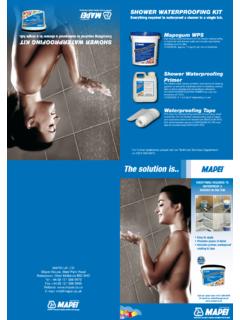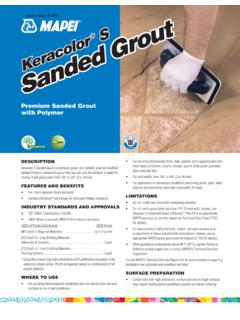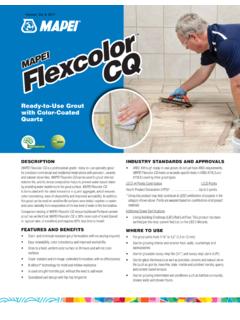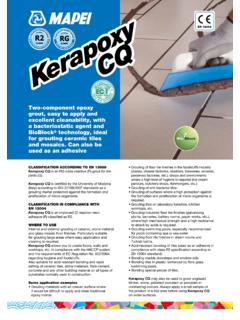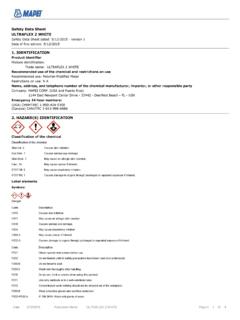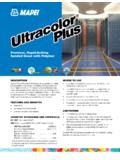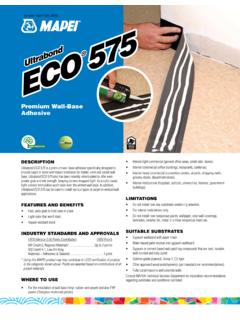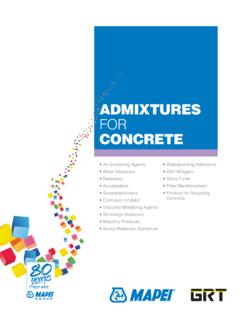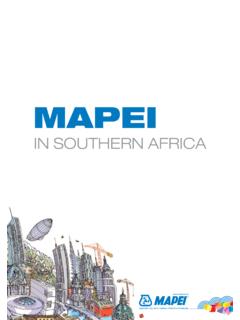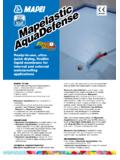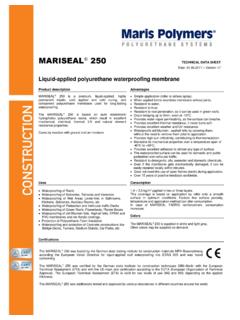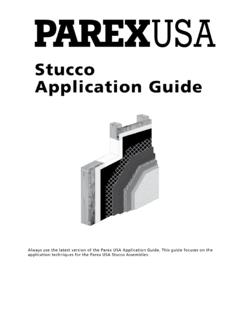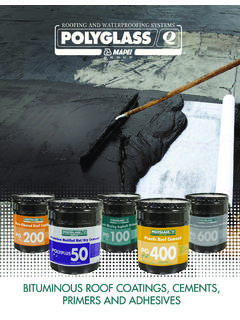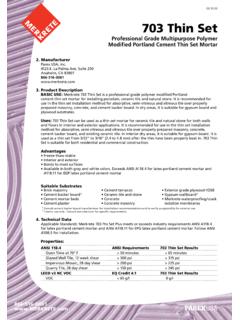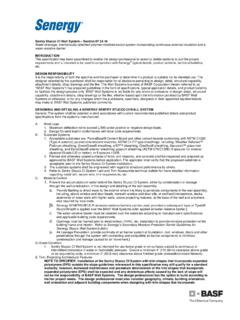Transcription of Professional Tile mortar with Polymer - Mapei
1 Version: Aug. 5, 2013. x 2 . afle ltr U. Professional Tile mortar with Polymer WITH ISO. NCE ST IN COMPLIANCE WITH. LIA A ISO STANDARDS. MP. ND. IN CO. ARD. C2E P1. S. ISO 13007 ISO 13007. EM. E. IV. ES. C. EN ADHESIVE OVER. TITIOUS ADH PLYWOOD. DESCRIPTION IEQ Credit , Low-Emitting Materials Flooring point Ultraflex 2 is a Professional -grade, single-component, high-performance, Polymer -modified thin-set mortar for interior and exterior installations of * Using this product may help contribute to LEED certification of projects in the ceramic, porcelain and dimensional natural-stone tile. This mortar has a categories shown above. Points are awarded based on contributions of all high content of unique dry Polymer , resulting in excellent adhesion to the project materials.
2 Substrate and tile. Ultraflex 2 meets or exceeds ANSI and ANSI requirements when mixed with water. Ultraflex 2 can be used for interior and Where to Use exterior installations of tile in most residential floor and wall applications. Most interior/exterior residential installations on floors and walls In commercial applications, use on interior floor and wall installations and Most interior/exterior commercial installations on floors exterior floors. Most interior commercial installations on walls Features and Benefits Installation of ceramic and porcelain tile, quarry tile, pavers, Saltillo tile, Polymer -enriched for high performance and deformability and many types of marble, granite and natural stone Smooth and creamy consistency for easy application Limitations Industry Standards and Approvals Install only at temperatures between 40 F and 95 F (4 C and 35 C).
3 ISO 13007: Classification C2EP1 Do not use for moisture-sensitive stone (green marble, some limestones and granites), agglomerate tiles or resin-backed tiles. Instead, use a ANSI: Exceeds ANSI and ANSI bond strength suitable epoxy or urethane adhesive. See the respective Technical Data requirements Sheet for more information. LEED Points Contribution LEED Points Do not use over dimensionally unstable substrates such as hardwood MR Credit 5, Regional Materials*.. Up to 2 points flooring, oriented strand board (OSB), substrates containing asbestos, or IEQ Credit , Low-Emitting metal. See the Suitable Substrates section. Materials Adhesives & Sealants ..1 point To use directly over gypsum-based patching or leveling substrates, apply suitable primer before use.
4 See Mapei Technical Bulletin 010313-TB, "Gypsum-Based Floors and Walls: Which Mapei Products Can Be Applied?".. x 2 Use a white mortar when installing light-colored stones 2. Use a low-speed mixing drill (at about 300 rpm), with rafle and translucent marble. an angled cross-blade mixer or double-box mixer. Ult Installations of tile over nonporous surfaces ( waterproofing membranes, sheet membranes, existing Mix thoroughly until the mixture becomes a smooth, homogenous, lump-free paste. Avoid prolonged tile, etc.) may require extended setting/curing times. mixing. Do not use for installations subject to prolonged water 3. Let the mixture stand ( slake ) for 10 minutes. immersion. 4. Remix. Use a Mapei liquid latex additive mortar system for 5.
5 If the mixture becomes heavy or stiff, remix without areas subject to severe freeze/thaw conditions. adding more liquid or powder. Suitable Substrates Product Application Concrete (cured at least 28 days) 1. Choose a typical notched trowel (see "Approximate Masonry cement block, brick, cement mortar beds and Coverage" chart) with sufficient depth to achieve more leveling coats than 80% mortar contact to both the tile and substrate for all interior applications, and more than 95%. Cement backer units (CBUs) see manufacturer's for exterior installations, commercial floor and wet installation guidelines applications. It may be necessary to back-butter the Gypsum wallboard interior walls in dry areas tile in order to meet these requirements.
6 (Refer to ANSI. only (See Technical Bulletin 010313-TB for priming specifications and TCNA Handbook guidelines.). instructions). 2. With pressure, apply a coat by using the trowel's flat APA and CANPLY Group 1 exterior-grade plywood side to key mortar into the substrate. (interior, residential and light commercial in dry 3. Apply additional mortar , combing it in a single conditions only). direction with the trowel's notched side. Properly prepared vinyl composition tile (VCT) and 4. Spread only as much mortar as can be tiled before cutback residue (interior only). product skins over. Open time can vary with jobsite Properly prepared existing ceramic and porcelain tile, conditions. quarry tile and pavers (interior only).
7 5. Place the tiles firmly into the wet mortar . Push the tiles Mapei waterproofing , crack-isolation and sound- back and forth in a direction perpendicular to trowel reduction membranes lines, to collapse the mortar ridges and to help achieve maximum coverage. Ensure proper contact between Surface Preparation mortar , tile and substrate by periodically lifting a few All substrates should be structurally sound, stable, dry, tiles to check for acceptable coverage. clean and free of any substance or condition that may 6. Remove excess mortar from the joint areas so that at reduce or prevent proper adhesion. least 2/3 of the tile depth is available for grouting (see See Mapei 's "Surface Preparation Requirements" ANSI guidelines).
8 Document in the Product Information section of the Tile & Stone Installation Systems page on Mapei 's Expansion and Website. Control Joints Provide for expansion and control joints as specified Mixing per TCNA Detail EJ171 or TTMAC Specification Guide Before starting, take appropriate safety precautions. See the 09 30 00 Detail 301EJ. Do not cover any expansion (Material) Safety Data Sheet for details. joints with mortar . For 10-lb. (4,54-kg) size: Cleanup 1a. I nto a clean mixing container, pour about 1 to Clean tools and tile while the mortar is fresh. qts. (0,95 to 1,14 L) of clean potable water. Gradually add 10 lbs. (4,54 kg) of powder while slowly mixing. Protection For 25-lb. (11,3-kg) size: Protect from traffic for 24 hours.
9 Protect from heavy 1b. Into a clean mixing container, pour about to 3 traffic for 7 days. qts. (2,37 to 2,84 L) of clean potable water. Gradually Protect from frost and rain for 7 days. add 25 lbs. (11,3 kg) of powder while slowly mixing. For 50-lb. (22,7-kg) size: 1c. I nto a clean mixing container, pour about 5 to 6 qts. (4,73 to 5,68 L) of clean potable water. Gradually add 50 lbs. (22,7 kg) of powder while slowly mixing.. x 2. ISO 13007 Classification afle tr Ul Classification Code Classification Requirement 145 psi (1 MPa) after standard aging, heat aging, water C2 (cementitious, improved adhesion). immersion and freeze/thaw cycles E (extended open time) psi (0,5 MPa) after 30 minutes P1 (normal adhesion to plywood) psi (0,5 MPa).
10 ANSI Specification Test Method Specification Standard Test Results ANSI shear strength, impervious ceramic (porcelain) > 200 psi (1,38 MPa) at 28 days 330 to 425 psi (2,28 to 2,93 MPa). mosaics ANSI shear strength, glazed > 300 psi (2,07 MPa) at 28 days 400 to 600 psi (2,76 to 4,14 MPa). wall tile ANSI shear strength, quarry > 150 psi (1,03 MPa) at 28 days 350 to 475 psi (2,41 to 3,28 MPa). tile to quarry tile ANSI shear strength, > 150 psi (1,03 MPa) at 28 days 150 to 200 psi (1,03 to 1,38 MPa). quarry tile to plywood Shelf Life and Application Properties at 73 F (23 C) and 50% relative humidity Packaging Shelf life 1 year Product Code Size and Color Open time* 30 minutes 0060053 Bag: 10 lbs.
